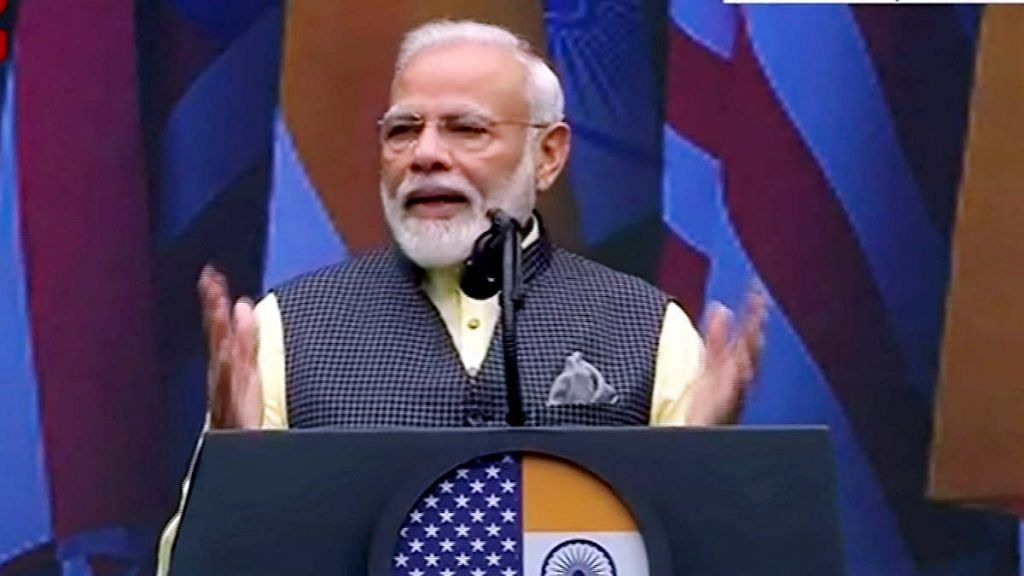Prime Minister Narendra Modi is perhaps more at home when he is abroad. Whether he be in the US taking victory lap holding President Donald Trump’s hand up, or in the UK or Rwanda, the prime minister behaves like a global rock star. From saying ‘Howdy’ in Texas to drumming in Japan, Modi makes sure his foreign policy initiatives look like energy-pumped performances.
These events have contributed to Modi’s larger-than-life image, nationally and internationally, because he has successfully used them to his advantage, always referring to himself but telling his audience that he stands and speaks there ‘on behalf of 130 crore Indians’. He invokes Pakistan and terrorism without mentioning the former, and draws the loudest cheer when he attributes his decision, like the abrogation of Article 370, to one that ‘people wanted’. Modi also knows the art of selling New Delhi’s ties with other countries, repeating over and over again how good a friend of India a particular country is – depending on which country he is making that statement from. However, it is yet not clear whether India’s external relations have improved as much.
Ask not what Modi can do for overseas Indians, ask what overseas Indians can do for him. Modi knows his voters. To win Indians, you must win NRIs too.
Because when it comes to overseas Indians’ love for Modi, an oft-quoted Salman Khan dialogue from Dabangg comes to mind: Main dil mein aata hoon, samajh mein nahin.
Also read: Tax cut gives Modi perfect pitch to win American investments
Modi’s calculus
Narendra Modi once called New York his “second home”. He was a regular in the US, even before he was a prime minister. “Summer of ’93: Check out young Narendra Modi hanging out in US” read an article in 2014.
After all, when Modi came to power in 2014, many NRIs had supported him and campaigned for him.
Modi hasn’t forgotten their power, and makes it a point to visit Indian-origin communities in whichever country he visits. According to official data, in his first term, Modi covered 92 countries, in 48 foreign visits.
There is deep-rooted angst among overseas Indians that Modi exploits to his advantage. Whether in Australia or America, Africa or the Middle East, they share a sense of longing for their culture while being unhappy with current events in India. Modi markets himself as the do-er, the saviour and a more active PM than his predecessor.
Also read: Modi faces lawsuit in Houston, and there’s a Khalistani lawyer behind the complaint
The angst of the Indians
Indian communities abroad hate Indian images of poverty, corruption, filth, urban chaos, casteism and reservation policies. But they do not want to give up their wealth and the envious respect they enjoy from fellow Indians. They are conscious of the fact that they are seen as “successful and rich”. In an alien land, they long to connect with the India they left behind, but they don’t actually want to go back to India. This creates a psychological divide.
There are over 45 lakh Indians in the US alone. America had become a dream destination of the entire middle class since the 1980-1990s. Their cultural environment back in India was conservative, even religious. Suddenly, they found themselves catapulted to the high end of material life in the US. That alienated them from what they believed was their Indian identity.
Not all those families had the legacy of the freedom movement or Gandhian values or Nehruvian ethos. They either did not know that Jawaharlal Nehru had started the elite IITs, nor did they care about Rajiv Gandhi’s struggles to bring the computer era in India. The upper castes in the US (read Brahminical) had a vague relationship with the RSS.
In a life surrounded by material pleasures, these Indian Americans began to seek psychological security in the vague idea of Hindutva. According to me, till the Rath Yatra of the late 1980s, followed by the destruction of the Babri Masjid by the RSS/VHP militants, these Indians were living in a sort of identarian vacuum. Then, the Hinduisation of the overseas Indians began. They stayed in US, but cursed Muslims as Pakistanis, discussed how India was being ruined by Nehruvian ethos and how it needed a strong leader who wasn’t afraid to take a stand.
Also read: If anything can defeat Modi, it’s the economy
A grand illusion
Narendra Modi provided a perfect foil for their angst. They could travel anywhere to participate in the Modi extravaganza. Here was a Hindu leader putting India on the map, or so they said. He helped them connect with each other and with India.
The overseas Indians are not too bothered about whether India gets a seat on the UN Security Council or whether it can beat China in economic achievements. They are happy that India is publicly recognised in such events, like by President Donald Trump in Houston. No other prime minister had converted their visits and rallies into political rock-‘n-roll. Even if there is no direct benefit to India or to them, they feel energised.
Narendra Modi is a magnificent illusion for Indians abroad. The ‘Howdy, Modi!’ event is a more powerful image for the prime minister than Chandrayaan-2. He had to go. For when they cheer him in the US and elsewhere, Indians back home will feel proud. And that’s where his real constituency is.
The author is a former editor and Congress member of Rajya Sabha. Views are personal.
